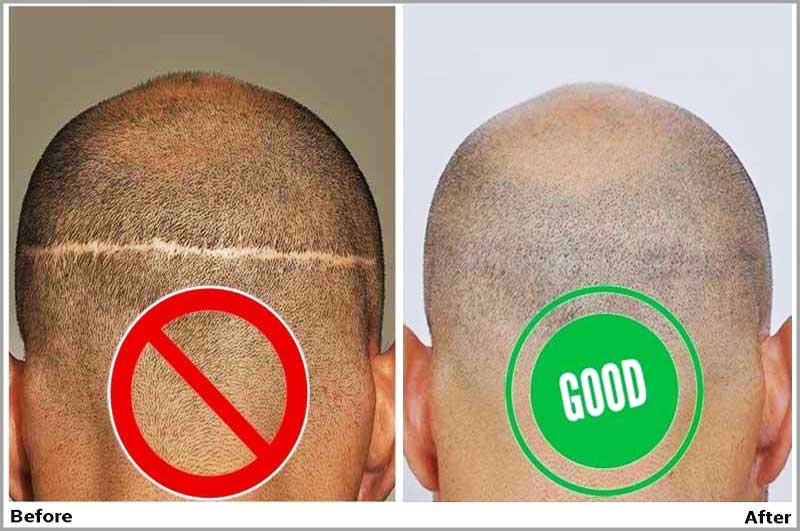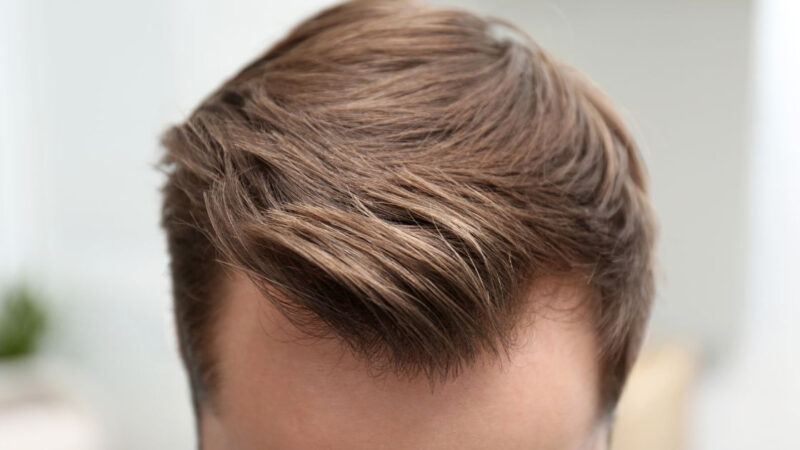 It is important to remember that all surgical procedures result in some degree of scarring and that also includes hair transplant surgery.
It is important to remember that all surgical procedures result in some degree of scarring and that also includes hair transplant surgery.
While this is undeniably true, in the case of CIT or FUE hair transplantation the scarring is very minimal and appears as white dots in some individuals. these dots are not visible to the naked eye when hair grows in the donor area unless it is shaved down to guard 0-1, Strip procedure in the other hand can results in the ear to ear scars that can be 2-3 inch wide, the strip scars can be very visible even with longer hair. Many patients are now asking the ultimate question – How can I avoid hair transplant scars?
Hair Transplant Scar
One of the tell-tale signs of having undergone hair restoration surgery is a linear scar across the back of your head. Hair transplant scars result from a method of hair transplantation known as FUT, or strip surgery. Hair transplant scars from this type of surgery are unpredictable in nature. Some lucky strip hair transplant patients will have only a slight, paper-thin scar. Others will develop thick, protruding scars of half an inch in width or more. The problem is that it is very difficult to determine how individual patients will heal and whether their scars will stretch in time.
Avoiding a Hair Transplant Scar
The only way to avoid having a linear strip scar is to elect not to have strip surgery. One alternative method to strip is FUE or follicular unit extraction. This method involves the excision of individual follicular units, one at a time. FUE does not result in a hair transplant scar because the doctor is not removing a large portion of tissue, nor is there a need for sutures. Without the linear scar left by strip surgery, FUE hair restoration surgery allows patients to restore their hairline, or add density where needed, without having to keep their hair long to conceal the donor area scar.
Strip Procedures and Scarring
During a strip procedure, the physician excises a ‘strip’ of tissue from the back and sides of the patient’s head. While surgical technicians begin dividing the tissue into individual follicular units, the physician closes the wound using sutures. In an ideal situation, the wound heals well and the scar is virtually undetectable underneath existing hair. However, in most situations, the scar will be quite visible and may even stretch over time. Having a hair transplant strip scar prevents patients from being able to wear their hair short or shaven without exposing the scar.
Other Drawbacks of Strip Procedures
In addition to the hair transplant scar that is left following a strip procedure, strip hair transplantation has a number of other drawbacks. Strip procedures are more invasive in nature than FUE, and the patient, therefore, requires additional healing and recovery time. Strip procedures also permanently distort hair growth angles, where the tissue and hair is removed, drawing even more attention to the linear scar. Yet another concern with strip procedures is that surgical technicians, and not the hair restoration surgeon, are often responsible for dissecting the strip into individual follicular units. This can contribute to fewer hairs per graft and even result in graft transection.
Camouflaging Hair Transplant Scars
If you already have a hair transplant scar, there are a few options available to help you conceal your scar. The best working scar treatment is FUE hair transplant scar repair. The first and easiest way is to simply leave the hair surrounding your scar long enough to conceal it. However, many men, particularly as their hair loss progresses, get tired of this and simply want to buzz or shave their heads. Another option involves the use of cosmetics, such as DerMmatch, which can help disguise the scar. Unfortunately, this is only a temporary solution. A more permanent option to consider is surgical scar revision. This involves “re-doing” the scar by excising it and suturing the wound again. Although this will occasionally result in a less noticeable scar, revisions often do not work. A better surgical option involves grafting permanent hair into the scar. This can be done via the FUE method and may require more than one ‘pass’ to achieve desired hair restoration results since yield tends to be lower in scar tissue versus virgin scalp.
Treating Donor Scars with FUE
When performing FUE we often run into individuals who do not desire additional strip scars or the risk of a wider scar. Sometimes they have a limited donor supply. Sometimes, they have a very tight donor area. If these individuals desire larger sessions, we face a problem. If we want a large session, we must shave a larger surface area. This may risk exposure to the donor scars.
In performing FUE we often run into individuals who do not desire additional strip scars or the risk of a wider scar. Sometimes they have a limited donor supply. Sometimes, they have a very tight donor area. If these individuals desire larger sessions, we face a problem. If we want a large session, we must shave a larger surface area. This may risk exposure to the donor scars. Patients do not want to take this chance oftentimes. In other instances, they are willing to suffer the embarrassment of exposing their linear donor scar for a short time to maximize their potential coverage from a single procedure. We have found that leaving the hair long allows us to obtain as many as 1500 grafts in a single procedure without shaving the entire donor area. When the hair is an average length, we can typically obtain between 800 and 1200 grafts without shaving or exposing the donor region. If there is significant scarring in the donor region, we are sometimes more limited in the number of grafts we can obtain without shaving the donor region. Sometimes individuals want a larger number of grafts, but they do not want their scars exposed. To deal with this problem, we devised a new method of concealing the donor strip scars after shaving the donor region. This patient was told by a well known and well-respected strip physician that he could obtain up to 600 grafts only from a subsequent strip harvest. He did not want to risk a wider scar or additional scars. therefore, he opted for the cole technique of FUE. We did our best to avoid shaving the donor region, but his follicular density was markedly reduced due to the multiple strip surgeries in the past. He wanted to maximize his results from this procedure so we devised a temporary hair prosthesis for the donor region and applied it to his donor scar. the photos of the scar before and after the hair prosthesis are depicted in this photo. we shaved the surrounding areas and performed our procedure to remove individual follicular groups. he had numerous lovely 2 and 3 hair groups. we extracted and placed approximately 1900 to 2000 grafts in total. this is well over what he could have obtained from the strip alone. we left the hair immediately above the scar slightly longer but combed it upward in this photo so you can see how well our hair prosthesis covers the strip scar. the hair surrounding the extraction sites in the shaved donor area will grow quickly. after one week, I advised him to cut his hair one even length so that it blends better with the area that we did not shave. this, along with the hair prosthesis, should help to conceal his scar. after the incision sites heal, which should take about 1 week, the worst-case scenario is he will look like a guy who got a bad hair cut rather than a guy who had a strip incision.








